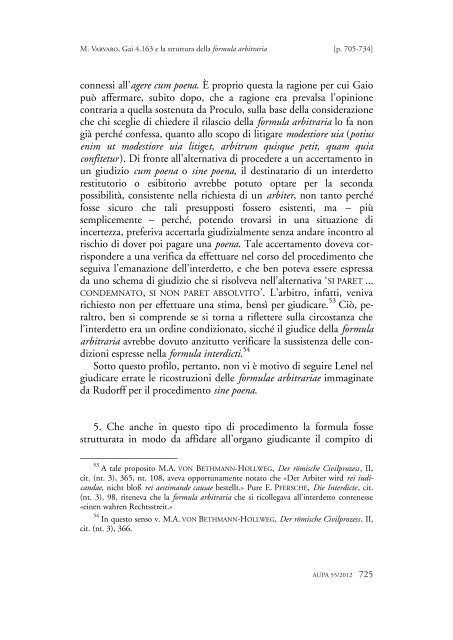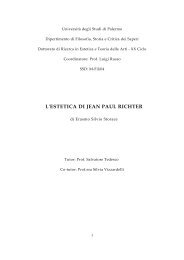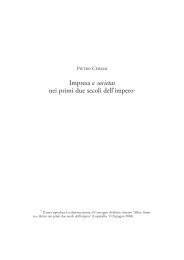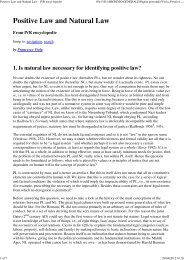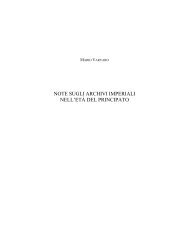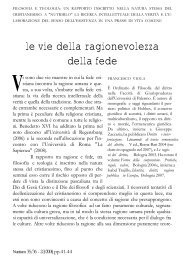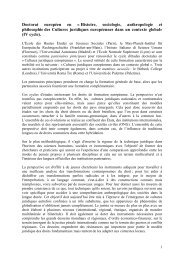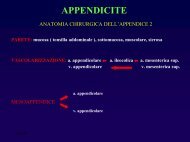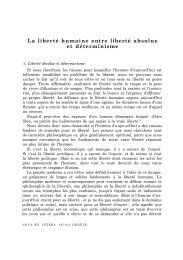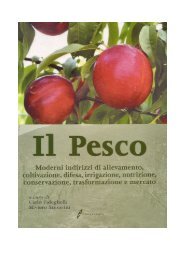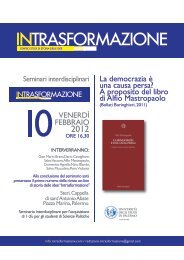M. VARVARO, Gai 4.163 e la struttura della formula arbitraria nell ...
M. VARVARO, Gai 4.163 e la struttura della formula arbitraria nell ...
M. VARVARO, Gai 4.163 e la struttura della formula arbitraria nell ...
Create successful ePaper yourself
Turn your PDF publications into a flip-book with our unique Google optimized e-Paper software.
M. Varvaro, <strong>Gai</strong> <strong>4.163</strong> e <strong>la</strong> <strong>struttura</strong> del<strong>la</strong> formu<strong>la</strong> <strong>arbitraria</strong> [p. 705-734]<br />
connessi all’agere cum poena. È proprio questa <strong>la</strong> ragione per cui <strong>Gai</strong>o<br />
può affermare, subito dopo, che a ragione era prevalsa l’opinione<br />
contraria a quel<strong>la</strong> sostenuta da Proculo, sul<strong>la</strong> base del<strong>la</strong> considerazione<br />
che chi sceglie di chiedere il ri<strong>la</strong>scio del<strong>la</strong> formu<strong>la</strong> <strong>arbitraria</strong> lo fa non<br />
già perché confessa, quanto allo scopo di litigare modestiore uia (potius<br />
enim ut modestiore uia litiget, arbitrum quisque petit, quam quia<br />
confitetur ). Di fronte all’alternativa di procedere a un accertamento in<br />
un giudizio cum poena o sine poena, il destinatario di un interdetto<br />
restitutorio o esibitorio avrebbe potuto optare per <strong>la</strong> seconda<br />
possibilità, consistente nel<strong>la</strong> richiesta di un arbiter, non tanto perché<br />
fosse sicuro che tali presupposti fossero esistenti, ma – più<br />
semplicemente – perché, potendo trovarsi in una situazione di<br />
incertezza, preferiva accertar<strong>la</strong> giudizialmente senza andare incontro al<br />
rischio di dover poi pagare una poena. Tale accertamento doveva corrispondere<br />
a una verifica da effettuare nel corso del procedimento che<br />
seguiva l’emanazione dell’interdetto, e che ben poteva essere espressa<br />
da uno schema di giudizio che si risolveva <strong>nell</strong>’alternativa ‘SI PARET ...<br />
CONDEMNATO, SI NON PARET ABSOLVITO’. L’arbitro, infatti, veniva<br />
richiesto non per effettuare una stima, bensì per giudicare. 53 Ciò, peraltro,<br />
ben si comprende se si torna a riflettere sul<strong>la</strong> circostanza che<br />
l’interdetto era un ordine condizionato, sicché il giudice del<strong>la</strong> formu<strong>la</strong><br />
<strong>arbitraria</strong> avrebbe dovuto anzitutto verificare <strong>la</strong> sussistenza delle condizioni<br />
espresse nel<strong>la</strong> formu<strong>la</strong> interdicti. 54<br />
Sotto questo profilo, pertanto, non vi è motivo di seguire Lenel nel<br />
giudicare errate le ricostruzioni delle formu<strong>la</strong>e <strong>arbitraria</strong>e immaginate<br />
da Rudorff per il procedimento sine poena.<br />
5. Che anche in questo tipo di procedimento <strong>la</strong> formu<strong>la</strong> fosse<br />
<strong>struttura</strong>ta in modo da affidare all’organo giudicante il compito di<br />
—————————<br />
53 A tale proposito M.A. VON BETHMANN-HOLLWEG, Der römische Civilprozess, II,<br />
cit. (nt. 3), 365, nt. 108, aveva opportunamente notato che «Der Arbiter wird rei iudicandae,<br />
nicht bloß rei aestimande causae bestellt.» Pure E. PFERSCHE, Die Interdicte, cit.<br />
(nt. 3), 98, riteneva che <strong>la</strong> formu<strong>la</strong> <strong>arbitraria</strong> che si ricollegava all’interdetto contenesse<br />
«einen wahren Rechtsstreit.»<br />
54 In questo senso v. M.A. VON BETHMANN-HOLLWEG, Der römische Civilprozess, II,<br />
cit. (nt. 3), 366.<br />
AUPA 55/2012 725


